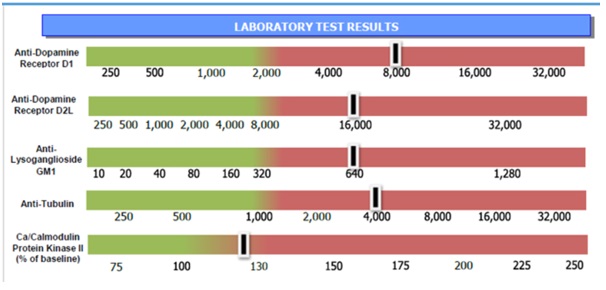
Spotlight on Lab Testing: The Cunningham Panel for PANS & PANDAS
By Dr. Kurt N. Woeller, DO
PANS (pediatric autoimmune neuropsychiatric syndrome) and PANDAS (pediatric autoimmune neuropsychiatric syndrome associated with streptococcal infections) are two similar autoimmune encephalopathy disorders involving dopamine receptors. PANDAS is specific for obsessive compulsive disorder (OCD), anxiety, insomnia, and/or movement disorders occurring post-strep infection, while PANS is linked to various other pathogens.
The dopamine receptor types 1 and 2 (DR1ab and DR2ab) are activated by immunoglobulins, aka antibodies, produced by the immune system in response to a primary infection. These antibodies bind to dopamine receptors and stimulate a direct loop effect within central nervous system (CNS). Anxiety, behavior changes, insomnia, and OCD can occur if antibodies primarily affect the CNS. If the activation affects the body in general then vocal and/or motor tics can occur, as well as Tourette’s syndrome or choreiform movements (involuntary spasmodic movements, particularly of the limbs and facial muscles). It is possible to have a combination of problems such as OCD and insomnia along with motor and/or vocal tics.
The Cunningham Panel from Moleculera Laboratory tests for DR1, DR2, anti-lysoganglioside GM1, anti-tubulin antibodies, and calcium/calmodulin kinase II (CaMKII):
1. DR1 – this is type 1 dopamine receptor (DR1ab)
2. DR2 – this is type 2 dopamine receptor (DR2ab)
3. Anti-lysoganglioside GM1 – gangliosides are components of cell membranes and involved in signal transduction effects for intracellular activity. GMI is involved in neuroplasticity, repair, and release of neurotrophin chemicals involved in nerve cell survival.
4. Anti-tubulin – tubulin is involved in cell structure and intracellular transport mechanisms.
5. Calcium/calmodulin kinase II (CaMKII) – this is an enzyme marker indicating how much dopaminergic system activity is occurring.
A positive antibody reactivity to any of these cellular components (DR1, DR2, anti-lysoganglioside GM1, anti-tubulin), indicates an autoimmune process within the nervous system.
The CaMKII helps to determine how much upregulation, aka increased activity, is occurring in the affected system. Therefore, a high CaMKII indicates abnormally heightened activity triggered by the immune system in response to an infection or allergen, e.g., foods.
Antibodies generated in response to an infection can occur from more than just strep bacteria. Other pathogens such as Lyme, mycoplasma, virus, fungus, and others are associated with PANS. Again, PANDAS is specific to problems occurring after a strep infection (group beta-hemolytic streptococcus).
Foods can drive cross-reactivity against dopamine receptors in the central nervous system too. Therefore, when considering cross-reactive antibodies to dopamine receptors, e.g., DR1, it is important to consider foods as a potential trigger. In most cases, obtaining at least a food IgG profile is useful.
When evaluating an individual with suspected or documented PANDAS or PANS it is important to understand that infectious agents can trigger cross-reactive antibodies seen in both conditions, but the pathogens themselves do not need to be present for symptoms to occur. Once the immune system has been engaged against a self-tissue target, e.g., brain, ongoing immune activity against that tissue doesn’t require the triggering agent. Therefore, in PANS/PANDAS individuals, when they have a symptom flare the need for infectious treatment is not likely necessary.
In conclusion, the Cunningham Panel (a blood draw test) is an important diagnostic tool for anyone suffering with a PANS/PANDAS condition or where the confluence of symptoms such as OCD, motor and/or vocal tics are occurring. There is always the potential that an individual’s receptors such as DR1 and anti-tubulin can be normal, but the CaMKII is elevated indicating upregulation within the dopaminergic system. This is significant because even though there is no evidence of autoimmune reactivity to a particular receptor type, the person’s nervous system is being aggravated by some offending agent and performing additional testing for an offending pathogen is warranted.




